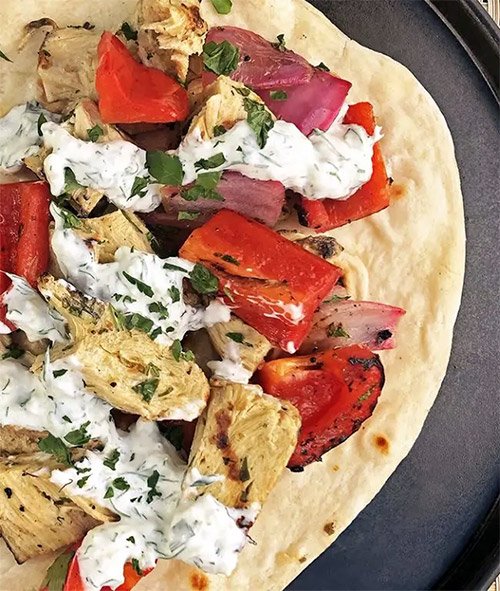Souvlaki, a popular Greek fast food, traditionally consists of small pieces of meat grilled on a skewer. However, our vegetable souvlaki offers a delightful plant-based alternative that doesn’t compromise on flavor or satisfaction. By combining colorful vegetables and protein-rich tofu with classic Greek seasonings, we create a dish that’s not only delicious but also suitable for vegetarians and vegans.
The Appeal of Vegetable Souvlaki
Before we dive into the recipe, let’s explore why vegetable souvlaki has become a beloved dish:
- Healthy: Packed with a variety of vegetables and plant-based protein.
- Flavorful: The Greek-inspired marinade infuses the vegetables and tofu with delicious Mediterranean flavors.
- Versatile: Can be customized with different vegetables based on preference or season.
- Fun to Eat: The skewer presentation makes it an interactive and enjoyable meal.
- Perfect for Grilling: Ideal for summer barbecues or year-round indoor grilling.

@seitansociety
The Recipe
Ingredients (Serves 4):
For the Souvlaki:
- 1 block (14 oz) extra-firm tofu, pressed and cut into 1-inch cubes
- 1 large zucchini, sliced into thick rounds
- 1 red bell pepper, cut into 1-inch pieces
- 1 yellow bell pepper, cut into 1-inch pieces
- 1 red onion, cut into 1-inch pieces
- 8 oz button mushrooms, cleaned
- 1 pint cherry tomatoes
For the Marinade:
- 1/4 cup olive oil
- 2 tablespoons lemon juice
- 2 cloves garlic, minced
- 1 tablespoon dried oregano
- 1 teaspoon dried thyme
- 1 teaspoon dried rosemary
- Salt and freshly ground black pepper to taste
For Serving:
- 4 pita breads, warmed
- Tzatziki sauce (store-bought or homemade)
- Fresh parsley or mint for garnish
Instructions:
- Press the tofu to remove excess moisture: Wrap the tofu block in paper towels or a clean kitchen towel and place a heavy object on top. Let it sit for about 30 minutes.
- While the tofu is pressing, prepare the marinade. In a bowl, whisk together olive oil, lemon juice, minced garlic, oregano, thyme, rosemary, salt, and pepper.
- Cut the pressed tofu into 1-inch cubes and place in a large bowl with the prepared vegetables.
- Pour the marinade over the tofu and vegetables, gently tossing to coat evenly. Cover and refrigerate for at least 30 minutes, or up to 2 hours for more flavor.
- If using wooden skewers, soak them in water for 30 minutes to prevent burning.
- Preheat your grill or grill pan to medium-high heat.
- Thread the marinated tofu and vegetables onto skewers, alternating ingredients for a colorful presentation.
- Grill the skewers for about 10-12 minutes, turning occasionally, until the vegetables are tender and lightly charred, and the tofu is golden brown.
- Serve the vegetable souvlaki skewers with warm pita bread, tzatziki sauce, and a sprinkle of fresh parsley or mint.

@oneteaspoonoflife
The Art of Grilling Vegetables
Grilling vegetables and tofu requires some attention to detail:
- Even Sizes: Cut vegetables into similar-sized pieces to ensure even cooking.
- Density Matters: Place denser vegetables like onions and bell peppers closer to the heat source.
- Don’t Overcrowd: Leave some space between pieces on the skewer for even heat distribution.
- Watch Closely: Vegetables can go from perfectly charred to burnt quickly, so keep an eye on them.
Nutritional Highlights
Vegetable souvlaki is not just delicious; it’s also packed with nutrients:
- Tofu: Excellent source of plant-based protein and calcium
- Colorful Vegetables: Provide a range of vitamins, minerals, and antioxidants
- Olive Oil: Contains heart-healthy monounsaturated fats
- Herbs: Offer additional antioxidants and flavor without added calories
Serving Suggestions
While delicious on its own, vegetable souvlaki pairs well with:
- Greek salad
- Lemon-herb rice pilaf
- Roasted potato wedges
- Hummus and baba ganoush for dipping
Variations to Explore
The beauty of vegetable souvlaki lies in its adaptability. Here are some variations to try:
- Summer Squash Medley: Include yellow squash and patty pan squash for a summer twist.
- Mediterranean Delight: Add artichoke hearts and sun-dried tomatoes to the skewers.
- Hearty Version: Include chunks of eggplant and halloumi cheese (for non-vegan option).
- Herb Infusion: Experiment with different herb combinations like dill, mint, or za’atar.
- Protein Swap: Try seitan or tempeh instead of tofu for a different texture and flavor.
Make-Ahead and Storage Tips
To make your meal prep easier:
- Prepare the marinade and chop vegetables up to a day in advance.
- Store marinated vegetables and tofu separately in the refrigerator.
- Grill skewers just before serving for the best texture and flavor.
- If you have leftovers, store them in an airtight container in the refrigerator for up to 2 days. Reheat gently in the oven or enjoy cold in a salad.
The Cultural Significance of Souvlaki
Souvlaki has been a part of Greek cuisine for thousands of years, with references to similar dishes dating back to ancient Greece. Traditionally made with meat, it has evolved over time to include various ingredients, reflecting changing dietary preferences and the versatility of Greek cuisine.
Our vegetable version honors this culinary tradition while adapting it for modern, plant-based diets. It embodies the Greek philosophy of using fresh, simple ingredients to create flavorful and satisfying meals.
Conclusion
Vegetable Souvlaki offers a delightful journey into Greek-inspired cuisine, proving that plant-based dishes can be just as satisfying and flavorful as their meat-based counterparts. With its vibrant colors, enticing aromas, and delicious taste, this dish is sure to become a favorite whether you’re vegetarian, vegan, or simply looking to incorporate more plant-based meals into your diet.
Remember, cooking is an art form that allows for personal expression. Don’t hesitate to experiment with different vegetables, herbs, or serving suggestions to make this dish your own. The most important ingredients are the love and care you put into preparing the meal.




